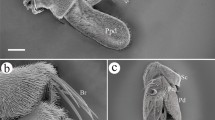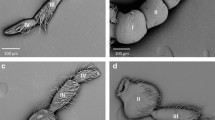Abstract
Portschinskia magnifica Pleske, 1926, is an endangered subcutaneous parasitic fly of voles that mimics bumblebees in appearance. Although the importance of antennae in Diptera has been repeatedly stressed, there is still a lack of morphology information of this group, let alone this species. Antennae of adult P. magnifica were studied with a stereoscopic microscope and scanning electron microscope. Six subtypes of antennal sensilla were observed on the funiculus and arista (one subtype of trichoid sensilla, one subtype of basiconic sensilla, and four subtypes of coeloconic sensilla). Sensilla on the antennal funiculus from one sample of both male and female flies were also mapped. Female P. magnifica bear a larger number of sensilla than males, and more sensilla were discovered on the posterior surface than on the anterior surface. However, what make this species special are the distinct structures and new morphological characteristics discovered in the antenna. The antennal funiculus of P. magnifica is completely enveloped by an antennal pedicel. A large number of branched or unbranched trichoid and basiconic sensilla are identified on the antennal funiculus. These two make the most numerous types of sensilla distributed all over the funicular surface. P. magnifica has the most coeloconic sensilla subtypes in previously studied oestrid flies. A total of four subtypes of coeloconic sensilla are found, with subtype I and subtype II on the proximal and middle part of the antennal funiculus and subtype III and subtype IV on the antennal arista. Two large bristles that resemble mechanoreceptors on the proximal two antennal segments located close to the arista are a unique feature. This has never been described in the oestrid funiculus. Interestingly, these bristles can appear as multi-tipped short structures in some individuals. P. magnifica lacks sensory pits that are usually abundant in other oestrid flies. The size, number, and distribution of sensilla on the male and female antennal funiculus are provided here, armed with a discussion of their presumable sensilla functions and evolutionary trends.






Similar content being viewed by others
References
Amer A, Mehlhorn H (2006) The sensilla of Aedes and Anopheles mosquitoes and their importance in repellency. Parasitol Res 99:491–499
Bay DE, Pitts CW (1976) Antennal olfactory sensilla of the face fly Musca autumnalis De Geer (Diptera: Muscidae). Int J Insect Morphol Embryol 5:1–16
Been TH, Schomaker CH, Thomas G (1988) Olfactory sensilla on the antenna and maxillary palp of the sheep head fly, Hydrotaea irritans (Fallen) (Diptera: Muscidae). Int J Insect Morphol Embryol 17:121–33
Blackwell A, Mordue AJ, Mordue W (1992) Morphology of the antennae of two species of biting midge: Culicoides impunctatus (Goetghebuer) and Culicoides nubeculosus (Meigen) (Diptera: Ceratopogonidae). J Morphol 213:85–103
Boo KS (1980) Antennal sensory receptors of the male mosquito, Anopheles stephensi. Z Parasitenkd 61:249–264
Bromely AK, Dunn JA, Anderson M (1980) Ultrastructure of the antennal sensilla of aphids. II. Trichoid, chordotonal and campaniform sensilla. Cell Tissue Res 205:493–551
Colwell DD, Hall MJR, Scholl PJ (2006) A synopsis of the biology, hosts, distribution, disease significance and management of the genera. In: Colwell DD, Hall MJR, Scholl PJ (eds) The oestrid flies: biology, host-parasite relationships, impact and management. CABI Publishing, Oxfordshire, pp 220–305
Colwell DD, Otranto D, Stevens JR (2009) Oestrid flies: eradication and extinction versus biodiversity. Trends Parasitol 25:500–504
Cribb BW (1997) Antennal sensilla of the female biting midge: Forcipomyia (Lasiohelea) townsvillensis (Taylor) (Diptera: Ceratopogonidae). Int J Insect Morphol Embryol 25:405–425
Dethier VG, Larsen JR, Adams JR (1963) The fine structure of the olfactory receptors of the blowfly. In: Zotterman Y (ed) Olfaction and Taste. Pergamon Press, Oxford, pp 105–114
Fernandes FF, Linardi PM, Chiarini-Garcia H (2002) Morphology of the antenna of Dermatobia hominis (Diptera: Cuterebridae) based on scanning electron microscopy. J Med Entomol 39:36–43
Foelix RF, Stocker RF, Steinbrecht RA (1989) Fine structure of a sensory organ in the arista of Drosophila melanogaster and some other dipterans. Cell Tissue Res 258:27–287
Green P, Hartenstein V (1997) Structure and spatial pattern of the sensilla of the body segments of insect larvae. Microsc Res Techniq 39:470–478
Guha L, Seenivasagan T, Bandyopadhyay P, Thanvir Iqbal S, Sathe M, Sharma P, Parashar BD, Kaushik MP (2012) Oviposition and flight orientation response of Aedes aegypti to certain aromatic aryl hydrazono esters. Parasitol Res (in press)
Hallberg E, Hansson BS (1999) Artropod sensilla: morphology and phylogenetic considerations. Microsc Res Techniq 47:428–439
Hallem EA, Dahanukar A, Carlson JR (2006) Insect odor and taste receptors. Annu Rev Entomol 51:113–35
Hunter FF, Adserballe CF (1996) Cuticular structures on the antennae of Hypoderma bovis De Geer (Diptera: Oestridae) females. Inter J Insect Morphol Embryol 25:173–181
Kaib M (1974) Die Fleisch- und Blumenduftrezeptoren anf der Antenne der Schmeigfliege Calliphora vicina. J Comp Physiol 95:105–121
Keil TA (1999) Morphology and development of the peripheral olfactory organs. In: Hansson BS (ed) Insect olfaction. Springer, Berlin, pp 5–47
Lewis CT (1971) Superficial sense organs of the antennae of the fly, Stomoxys calcitrans. J Insect Physiol 39:36–43
McIver S, Beech M (1986) Prey finding behavior and mechano-sensilla of larval Toxorhynchites brevipalpis Theobald (Diptera: Culicidae). Int J Insect Morphol Embryol 15:213–225
Ngern-klun R, Sukontason K, Methanitikorn R, Vogtsberger RC, Sukontason KL (2007) Fine structure of Chrysomya nigripes (Diptera: Calliphoridae), a fly species of medical importance. Parasitol Res 100:993–1002
Poddighe S, Dekker T, Scala A, Angioy AM (2010) Olfaction in the female sheep botfly. Naturwissenschaften 97:827–835
Ross KTA (1992) Comparative study of the antennal sensilla of five species of root maggots: Delia radicum L., D. floralis F., D. antique Mg., D. platura Mg. (Diptera: Anthomyiidae), and Psila rosae F. (Diptera: Psilidae). Int J Insect Morphol Embryol 21:175–197
Ross KTA, Anderson M (1987) Morphology of the antennal sensilla of the cabbage root fly, Delia radicum L. (Diptera: Anthomyiidae). Int J Insect Morphol Embryol 16:331–342
Schmitz H, Bleckmann H (1997) Fine structure and physiology of the infrared receptor of beetles of the genus Melanophila (Coleoptera: Buprestidae). Int J Insect Morphol Embryol 26:205–215
Schneider D (1964) Insect antenna. Annu Rev Entomol 9:103–122
Setzu MD, Poddighe S, Angioy AM (2011) Sensilla on the antennal funiculus of the blow fly, Protophormia terraenovae (Diptera: Calliphoridae). Micron 42:471–477
Shanbhag SR, Singh K, Singh RN (1995) Fine structure and primary sensory projections of sensilla located in the sacculus of the antenna of Drosophila melanogaster. Cell Tissue Res 282:237–249
Shanbhag SR, Muller B, Steinbrecht RA (1999) Atlas of olfactory organs of Drosophila melanogaster 1. Types, external organization, innervation and distribution of olfactory sensilla. Int J Insect Morphol Embryol 28:377–397
Sukontason K, Sukontason KL, Piangjai S, Boonchua N, Chaiwonga T, Ngern-kluna R, Sripakdeea D, Vogtsberger RC, Olson JK (2004) Antennal sensilla of some forensically important flies in families Calliphoridae, Sarcophagidae and Muscidae. Micron 35:671–679
Sukontason K, Methanitikorn R, Chaiwong T, Kurahashi H, Vogtsberger RC, Sukontason KL (2007) Sensilla of the antenna and palp of Hydrotaea chalcogaster (Diptera: Muscidae). Micron 38:218–223
Wang X, Zhong M, Wen J, Cai J, Jiang H, Li Y, Al SM, Xiong F (2012) Molecular characterization and expression pattern of an odorant receptor from the myiasis-causing blowfly, Lucilia sericata (Diptera: Calliphoridae). Parasitol Res 110:843–851
Wiegmanna BM, Trautweina MD, Winklera IS, Barra NB, Kima JW, Lambkinc C, Bertonea MA, Cassela BK, Baylessa KM, Heimberge AM, Wheelerf BM, Petersone KJ, Papeg T, Sinclairh BJ, Skevingtoni JH, Blagoderovj V, Caravask J, Kuttyl SN, Schmidt-Ottm U, Kampmeiern GE, Thompsono FC, Grimaldip DA, Beckenbachq AT, Courtneyr GW, Friedrichk M, Meierl R, Yeatesd DK (2011) Episodic radiations in the fly tree of life. Proc Natl Acad Sci USA 108:5690–5695
Zacharuk RY (1985) Antennal sensilla. In: Kerkut GA, Gilbert LI (eds) Comparative insect physiology, biochemistry and pharmacology, vol 6. Pergamon, Oxford, pp 1–69
Zhang F, Zhang ZN (2000) Comparative study on the antennal sensilla of various forms of Myzus persicae. Acta Ent Sin 143:131–136
Zhang D, Wang QK, Hu DF, Li K (2012) Sensilla on the antennal funiculus of the horse stomach bot fly, Gasterophilus nigricornis. Med Vet Entomol (in press)
Zumpt F (1965) Myasis in man and animals in the Old World. Butterworth, London, pp 1–267
Acknowledgments
We are grateful to Ms. Hui Zhang and Ms. Quan Han (Beijing Forestry University), who gave us invaluable help with this study. This study was supported by the Fundamental Research Funds for the Central Universities (no. BFU-YX2011-24), the Chinese Postdoctoral Science Foundation (no. 20100470009, no. SFG-201104059), the Programme for College Student of Beijing Forestry University Scientific and Technological Innovation, and the State Forestry Administration, China (no. 201004054).
Author information
Authors and Affiliations
Corresponding author
Rights and permissions
About this article
Cite this article
Zhang, D., Wang, QK., Hu, DF. et al. Cuticular structures on antennae of the bot fly, Portschinskia magnifica (Diptera: Oestridae). Parasitol Res 111, 1651–1659 (2012). https://doi.org/10.1007/s00436-012-3004-9
Received:
Accepted:
Published:
Issue Date:
DOI: https://doi.org/10.1007/s00436-012-3004-9




